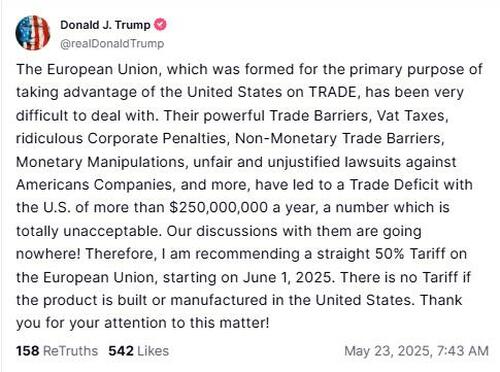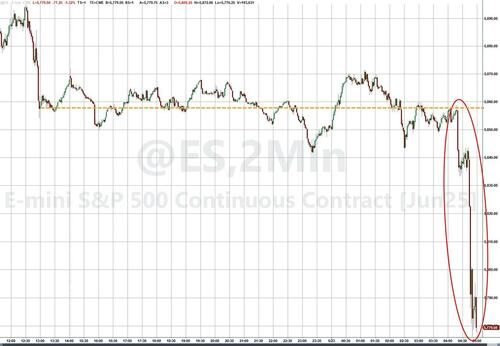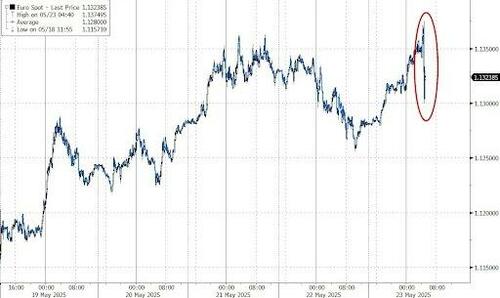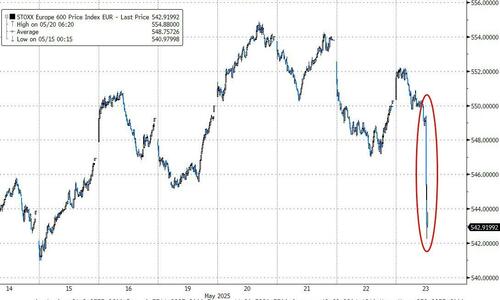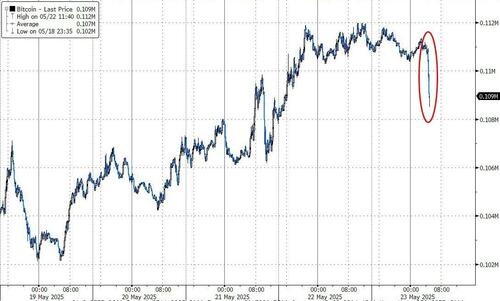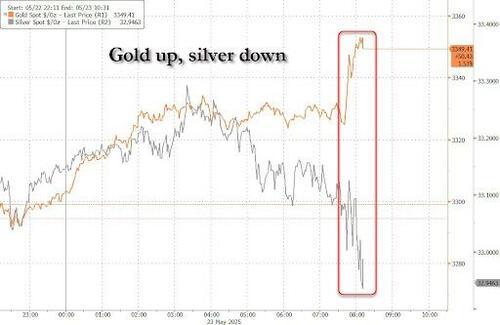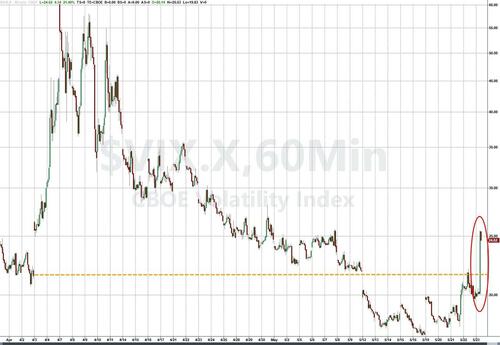It was set to be a relatively quiet day, with stock futures unchanged, yields modestly lower, bitcoin just shy of record highs... and then Trump woke up.
First, in a post on his Truth Social just after 7:20am ET, the clearly angry president said that unless iPhone that are sold in the US are not also built in the US, then a "Tariff of at least 25% must be paid by Apple to the U.S."
The comment immediately wiped out tens of billions in value from AAPL stock, which tumbled $10 to $193, or more than 4%...
... and while the news also dragged broader futures lower, Trump saved his second market punishment for 25 minutes later when at 7:45am ET, the president doubled down on his post-awakening stream of Truth Social consciousness and wrote that he is "recommending a straight 50% Tariff on the European Union, starting on June 1, 2025. There is no Tariff if the product is built or manufactured in the United States."
His ire was likely triggered by overnight reports that EU talks with the US had gone nowhere, which is why he said that Europe's "powerful Trade Barriers, Vat Taxes, ridiculous Corporate Penalties, Non-Monetary Trade Barriers, Monetary Manipulations, unfair and unjustified lawsuits against Americans Companies, and more, have led to a Trade Deficit with the U.S. of more than $250,000,000 [sic] a year, a number which is totally unacceptable."
The post slammed S&P futures which were already reeling from the AAPL news, and spoos tumbled about 100 points lower from where they were just minutes earlier.
The news also slammed bond yields, the euro, European stocks, crude, and bitcoin...
... while gold was the only asset that rose on the renewed trade war escalation.
VIX spiked back above pre-Liberation Day lows...
Now, we wait to see if 'retail' will step back in to save the day (because macro hedge funds have been positioning for just this kind of Trump-driven turmoil)
The sudden shift in Trump's temperament, not to mention markets, underscores the ongoing risk that shifts in US policy can abruptly upend market dynamics at short notice. Markets had rebounded in recent weeks on optimism that Trump was softening his approach to the tariffs and investor attention had shifted to concerns about the ballooning US debt and deficits.
“It’s going to keep markets on edge,” said Aneeka Gupta, head of macroeconomic research at Wisdom Tree UK Ltd. “Markets were hoping news on tariffs had abated until at least the 90-day pause expired, but that’s clearly not the case. Uncertainties are here to stay. We’re in for a period of very high volatility.”
The rest of this post was going to be the a recap of the overnight news, but obviously none of that matters now that Trump decided to take a nuke to newsflow and blow everything up.
As US traders were scrambling to pick up the pieces of wtf just happened, European stocks were dumping, while traders ramped up bets on further ECB monetary easing after dire wage data earlier. Money markets priced in 65 bps of additional easing in 2025, which implies three quarter-point rate cuts at the ECB’s remaining five scheduled decisions is most likely. Traders favored just two such reductions before Trump’s social media posts.
“I think a lot of people see it as just another Trump tweet, which can be cancelled by another one in a few hours or a few days,” David Kruk, head of trading at La Financiere de L’Echiquier. “I don’t think a lot of European investors are selling on the news.” The same can no be said for US - or certainly crypto investors - who clearly relish this kind of rollercoaster idiocy.
Kruk said the bigger issue for investors remains the budget credibility of the US. Bond markets this week have jolted after Moody’s Ratings stripped the US of its top credit rating and the House’s approved a tax bill that is likely to increase the debt burden.
This week’s selloff in long-dated Treasuries presents a “great entry point” for buyers with the 30-year yield above 5%, according to Bank of America Corp. strategist Michael Hartnett.
The US government is likely to heed warnings from bond vigilantes, who are “incentivized to punish the unambiguously unsustainable path of debt and deficit,” the strategist said.
The Stoxx 600 is little changed as gains in mining and travel shares are offset by losses in insurance and consumer products. Here are the biggest European movers (or at least until the Trump tweets):
Asian equities rebounded, putting them on track for a sixth week of gains, as risk appetite recovers on encouraging progress in trade negotiations. The MSCI Asia Pacific index rose as much as 0.7%, with Japanese shares including Nintendo, Mitsubishi Heavy and Hitachi among the biggest boosts. The Philippines’ stock benchmark jumped 1.7%, recouping Thursday’s loss spurred by a call for the cabinet to quit. Stocks also advanced in India. Investors are looking past worries over US fiscal deficit that had weighed on regional equities throughout the week. Assurances of open communication between US and China also helped lift sentiment.
In FX, the Bloomberg Dollar Spot Index eyes its lowest close since December 2023 as it falls 0.5% on concerns over the US fiscal outlook. The drop accelerate after Trump's tweets. The Swedish krona leads G-10 currencies against the greenback, rising 1%. The pound adds 0.6%, briefly touching a fresh three-year high of $1.35. The euro also climbs 0.6%. Meanwhile, mainland Chinese shares bucked the trend, falling 0.8%. Benchmarks in Taiwan and South Korea also ended slightly lower.
In rates, treasuries extdended their gains, with the 10Y sliding as low as 4.45% after hitting 4.62% yesterday, before moving modestly higher. 30-year yields fell 2 bps to 5.02% having reached 5.15% during Thursday’s session. Longer dated maturities also outperform in Europe with UK and German 30-year borrowing costs falling 2-3 bps each.
In commodities, oil prices are of course in the red, with WTI falling 0.3% to $61 a barrel, because Trump wants to make sure there is zero capex in the shale patch and watch production crater, sending oil to triple digits in a year or so when the bullwhip effect from his punitive policies finally catches up. Spot gold climbs $39 to around $3,333/oz. Bitcoin is steady just above $111,000.
On today's calendar we get New Home Sales and the Kansas Fed.
Market Snapshot
Top Overnight News
Tariffs/Trade
A more detailed look at global markets courtesy of Newsquawk
APAC stocks were mostly in the green albeit with gains in the region capped following the indecisive performance stateside where participants digested PMI data and the House approved US President Trump's tax bill to send it to the Senate. ASX 200 eked mild gains as the strength in real estate, energy, tech, telecoms and financials was partially offset by losses in defensives and miners. Nikkei 225 returned to above the 37,000 level with the index unfazed by the firmer-than-expected Core CPI data, while Japanese Economy Minister Akazawa is visiting the US for a third round of talks and is reportedly planning to visit again late next week for a fourth round of discussions. Furthermore, Japanese PM Ishiba had a call with US President Trump and discussed US tariffs, diplomacy and security although no major developments were announced. Hang Seng and Shanghai Comp gained but with advances in the mainland limited in the absence of any fresh significant macro drivers, although there were some talks between the US and China at a deputy ministerial level, in which the US Deputy Secretary of State spoke with his Chinese counterpart on Thursday and discussed a wide range of issues of mutual interest. The two agreed on the importance of keeping open lines of communication.
Top Asian News
European bourses opened incrementally firmer and trudged higher throughout the morning - though more recently, some downside has been seen to display a mixed picture in Europe. European sectors opened without a clear bias, but have since moved to a strong positive direction. Basic Resources tops the pile, joined closely by Travel & Leisure and then Healthcare. Retail lags. US equity futures are flat/modestly firmer, following similar price action seen in Europe. Docket ahead is lacking in terms of Tier 1 data, but the focus will be on Fed speak from Musalem and Cook.
Top European News
FX
Fixed Income
Commodities
Geopolitics
US Event Calendar
Central Banks :
DB's Jim Reid concludes the overnight wrap
After a heavy selloff on Wednesday, markets began to stabilise again over the last 24 hours, despite investors’ ongoing fears about the fiscal situation. In particular, long-end Treasury yields started to fall again, with the 30yr yield (-4.3bps) moving down to 5.05%, whilst the dollar index (+0.37%) also recovered. But even so, there were still several signs of concern, as the 30yr Treasury yield had moved as high as 5.15% on an intraday basis, and a similar pattern was being echoed globally. For example, Japan’s 30yr yield (+3.3bps) moved up to 3.18% yesterday, the highest since that maturity was first issued in 1999. And in the UK, the 30yr yield (+3.2bps) moved up to 5.55%, closing just shy of its highest level since 1998.
Those moves came as the US House of Representatives narrowly passed the tax bill yesterday, with an incredibly tight 215-214 margin in favour. As a reminder, that would extend the Trump tax cuts from his first term, which are currently due to expire at the end of this year, and it also includes a $4tn increase in the debt ceiling. However, there’s still some way to go before passage, as it also has to pass the Senate, which is expected to make changes to the bill. For instance, fiscal hawks in the Senate are unhappy about some of the measures, with Senator Rand Paul having said “I’m not voting to raise the debt ceiling $4 trillion to $5 trillion”, whilst Senator Ron Johnson has described the deficits from the House bill as “completely unacceptable”.
The Republicans have a slightly more comfortable margin in the Senate of 53-47, but they can still only afford to lose 4 votes, and both chambers of Congress need to pass the same version of the bill before it can become law. So any changes made by the Senate will have to be re-voted on by the House, where it already passed by just one vote.
Treasury Secretary Bessent has previously set a goal of July 4 for the bill to be signed, and Trump said in a post that “it’s time for our friends in the United States Senate to get to work, and send this Bill to my desk AS SOON AS POSSIBLE! There is no time to waste.” Another effective deadline is the late summer anyway, as the CBO have estimated that the debt ceiling will become an issue around August-September again, so Congress would need to raise the limit by then to avoid default.
Despite the fiscal concerns, US equities were comparatively resilient, with the S&P 500 (-0.04%) stabilising after its sharp -1.61% decline on Tuesday. That said, there was a late slump, with the index down -0.6% in the final 30 minutes of trading, having been in positive territory for much of the session. And nearly two-thirds of the S&P 500’s constituents declined, with defensive sectors including utilities (-1.41%) and healthcare (-0.76%) underperforming. Moreover, it would have been a larger decline had it not been for the Magnificent 7 (+0.78%), which outperformed after three consecutive declines.
One factor helping US assets to stabilise was some stronger US economic data, which continued to point away from a recession. For instance, the flash composite PMI for May was up to 52.1, up from 50.6 in April, and above the 50-mark that separates expansion from contraction. Moreover, the weekly initial jobless claims also remained in their recent range, coming in at 227k over the week ending May 17 (vs. 230k expected). So again, that showed no sign of a deterioration in the labour market, with the numbers still within their pre-Liberation Day range.
The rally also got a fresh boost from the decline in bond yields, with the 2yr Treasury yield (-2.8bps) falling back to 3.99%, whilst the 10yr yield (-7.0bps) fell back to 4.53%. In part, that followed comments from Fed Governor Waller, who suggested that if the tariffs were closer to 10% and that was done by July, then the Fed would be well placed “to kind of move with rate cuts through the second half of the year”.
In other Fed-related news, yesterday evening the US Supreme Court said that the Federal Reserve was an exception when it comes to the President’s ability to remove officials, referring to the Fed as a "uniquely structured, quasi-private entity" that was different to other independent agencies. So that offered a bit more certainty on the position of senior Fed officials, and whether Chair Powell might be removed before his term as Fed Chair ends in May 2026.
Back in Europe, the last 24 hours saw a much weaker performance, with the STOXX 600 (-0.64%) posting its biggest decline in over 6 weeks. That came amidst a disappointing set of economic data, with the flash PMIs narrowly falling into contractionary territory. For example, the Euro Area composite PMI was down to 49.5 in May (vs. 50.6 expected), which is the first sub-50 reading since December. So even though the data wasn’t showing an aggressive contraction, it added to the signs that the Euro Area economy had lost momentum since Liberation Day, leading to a bigger risk-off move. That was echoed in the country prints as well, with the composite PMIs in Germany (48.6), France (48.0) and the UK (49.4) also coming in below the 50 mark. Nevertheless, it wasn’t all bad news, and in Germany the Ifo’s business climate indicator rose to an 11-month high of 87.5 in May (vs. 87.3 expected).
That backdrop saw European equities lose ground across the board, whilst sovereign bond spreads also widened. So even as 10yr bund yields (-0.3bps) came down slightly, those on 10yr OATs (+1.0bps) and BTPs (+0.9bps) moved higher. So it also meant that the Italian 10yr spread over bunds moved back above 100bps, after recently falling below that mark for the first time since 2021.
Overnight in Asia, the mood has become more positive overnight given the recovery in US Treasuries. So that’s supported gains across the board, including for the Nikkei (+0.61%), the Hang Seng (+0.58%), the CSI 300 (+0.30%) and the Shanghai Comp (+0.08%). The one exception to that is the KOSPI (-0.04%), which has posted a very modest decline. But looking forward, US and European equity futures are also in positive territory, with those on the DAX (+0.10%) and the S&P 500 (+0.05%) both slightly higher.
The other main news overnight has been the latest CPI print from Japan. It showed headline CPI remaining at +3.6% in April (vs. +3.5% expected). Moreover, the core measure of inflation (excluding fresh food) was up to +3.5% (vs. +3.4% expected), which was its fastest level since January 2023. The Japanese Yen has strengthened +0.42% against the US Dollar this morning, although much of that has been driven by dollar weakness, with the dollar index down -0.30% overnight.
Elsewhere, one asset that continued to outperform was Bitcoin, which moved up to another record high of $111,092 yesterday. On the theme of cryptocurrencies, Marion Laboure put out a note yesterday on the GENIUS Act, which would establish rules around stablecoins.
To the day ahead now, and data releases include UK retail sales for April, French consumer confidence for May, and US new home sales for April. Central bank speakers include the Fed’s Musalem, Schmid and Cook, and the ECB’s Lane.
Source link




